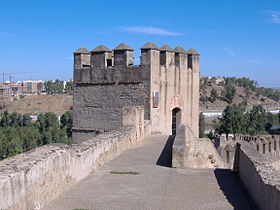Second Siege of Badajoz (1811)
| Second Siege of Badajoz (1811) | |||||||
|---|---|---|---|---|---|---|---|
| Part of the Peninsular War | |||||||
 Part of Badajoz's ancient fortifications |
|||||||
|
|||||||
| Belligerents | |||||||
|
|
|
||||||
| Commanders and leaders | |||||||
|
|
|
||||||
| Strength | |||||||
| 1st phase: 20,700 2nd phase: 14,000 |
1st phase: 4,000 2nd phase: 3,600 |
||||||
| Casualties and losses | |||||||
| 1st phase: 733 2nd phase: over 231 |
unknown | ||||||
The Second Siege of Badajoz (22 April – 12 May and 18 May – 10 June, 1811) saw an Anglo-Portuguese Army, first led by William Carr Beresford and later commanded by Arthur Wellesley,The Viscount Wellington, besiege a French garrison under Armand Philippon at Badajoz, Spain. After failing to force a surrender, Wellington withdrew his army when the French mounted a successful relief effort by combining the armies of Marshals Nicolas Soult and Auguste Marmont. The action was fought during the Peninsular War, part of the Napoleonic Wars. Badajoz is located 6 kilometres (4 mi) from the Portuguese border on the Guadiana River in western Spain.
While Wellington faced Marshal André Masséna's Army of Portugal in the north, his lieutenant Beresford attempted to capture French-held Badajoz in the south. Beresford invested the city in April but Philippon's garrison successfully fended off his attacks. The siege was briefly lifted while the Battle of Albuera was fought on 16 May. Though both sides suffered horrific casualties, Beresford emerged the victor and Soult retreated to the east. Wellington brought reinforcements from the north and resumed the siege, but progress was slow in the face of spirited French resistance. Meanwhile, Masséna's replacement Marmont brought large forces south to join Soult. The British commander lifted the siege after being menaced by the numerically superior French army led by Soult and Marmont.
Hoping to assist Marshal André Masséna's invasion of Portugal, Emperor Napoleon ordered Marshal Nicolas Soult to act. Accordingly, Soult set out in January 1811 with 13,500 foot soldiers, 4,000 horse, and 2,000 gunners and sappers to besiege Badajoz. In a preliminary operation, Soult captured Olivenza in a two-week siege that ended on 23 January. The French seized 4,161 Spanish prisoners and 18 guns for an admitted loss of only 15 killed and 40 wounded. On 27 January, Soult's army invested Badajoz. Despite the interference of a 15,000-man Spanish relief army, the results were all the French could have hoped for. On 19 February, Soult sent Marshal Édouard Mortier to deal with the Spanish army. Mortier won a crushing victory in the Battle of the Gebora. The Spanish lost 850 killed and wounded plus 4,000 men, 17 guns, and 6 colors captured. French casualties only numbered 403. Turning to the siege, Soult forced a surrender on 11 March. The 4,340-man Spanish garrison plus 2,000 fugitives from the Battle of the Gebora lost about 1,000 killed and wounded while the rest became prisoners. The French sustained 1,900 casualties in the siege.
...
Wikipedia
